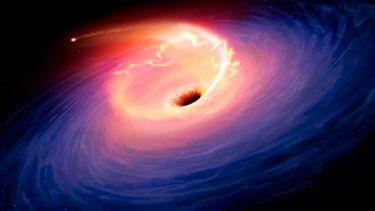Active Galaxies, Quasars and Starbursts
Active Galactic Nuclei (AGN) and their more luminous counterparts, quasars, are some of the most extreme and highly luminous objects in the Universe.

Academic staff: Professor Clive Tadhunter, Dr James Mullaney
PhD students: Freya Barwell, Dustin Mason, Summer McLaughlin
Active galaxies
Active Galactic Nuclei (AGN) emit at least as much radiation by themselves as the integrated light of all the stars in a typical galaxy, yet this radiation is produced in a region that is smaller than the solar system.
Therefore one aspect of AGN research concentrates on understanding the source of their prodigious energy output.
It is thought that the power of AGN is most likely to be produced by the release of gravitational energy as material is accreted into the vicinity of a supermassive black hole.
However, many of the details - in particular the generation of the powerful jets that are associated with some AGN, and the triggering mechanism - remain obscure.
The research of our group concentrates on X-ray, optical, infrared and radio studies of active galaxies and quasars, to investigate the links between galaxy evolution and nuclear activity.
Starburst galaxies
Starbursts are important features of early galaxy evolution. Many of the distant, high-redshift galaxies we detect are in a "starbursting" phase, often apparently provoked by a violent gravitational interaction with another galaxy.
In fact, if we did not know that major starbursts existed, we would indeed have difficulties explaining the key properties of the Universe.
Using state-of-the-art observatories and new theoretical approaches, we use the young massive star clusters generated in these very violent environments to follow the recent star formation and interaction histories of their host galaxies.
We constrain the precise physical conditions generated in these extreme environments, such as the effects of gaseous outflows ("feedback") from the young massive star clusters on the interstellar medium surrounding them.
Current PhD opportunities in this topic
Finding and measuring growing black holes in the next generation of astronomical surveys
